Following the successful deployment of the Chang'e-3 mission to the surface of the Moon, the Chinese National Space Administration (CNSA) has announced plans to build and launch a sample return mission to Earth's natural satellite by 2017.
This would be China's fifth lunar probe, but its mission would not be to investigate the Moon from orbit, or simply land on its surface, but rather collect rock and soil samples for return to Earth. A sample-return mission is perhaps the most difficult type of mission that can be carried out today.
The real reason why CNSA is moving so fast with developing spacecraft meant to explore the Moon is that it plans to land astronauts there after 2020. The 2017 mission represents the beginning of the third and final step in the agency's lunar exploration program, which began with Chang'e-1 in 2007.
Chang'e-2, also a lunar orbiter, launched in 2010, and successfully produced images of the Moon's surface. Chang'e-3, the probe that landed in Mare Imbrium on Saturday, represents the second stage of the lunar exploration initiative. The spacecraft includes a six-wheeled rover called Yutu.
Chang'e-3 is the only probe to make a soft landing on the Moon since the Soviet Union Luna mission conducted 37 years ago. China is now part of an exclusive group of nations that managed soft landings on Earth's natural satellite, a group that only includes the United States and the Soviet Union.
Another purpose of the Chang'e-3 mission is to determine whether or not current spacecraft manufacturing practices the CNSA uses are enough to safeguard vehicles on the lunar surface, PhysOrg reports.
Like its predecessor, the future Chang'e 4 lander will face harsh conditions on the Moon. Temperatures, for example, can vary wildly over relatively short intervals, from 120 degrees Celsius (248 ºF) to -180 ºC (-184 ºF).
The vehicle, to be launched in 2015, will represent a precursor of the 2017 sample-return mission, called Chang'e-5. The latter will attempt to return at least 2 kilograms (4 pounds) of lunar soil and rock samples back to the Earth. It will launch to space aboard a Long March 5 heavy-lift delivery system.
The fact that Chinese President Xi Jinping and Premier Li Keqiang were present at the Beijing Aerospace Control Center when Chang'e-3 landed on the lunar surface testifies to the increasing importance of the Chinese space program as a source of pride and prestige for the Asian nation.
“China's moon probe is a way to exhibit to the world that we have acquired advanced space technology, which is more sophisticated than nuclear technology, and it is also a way to win international recognition as a big power,” explained He Qisong, who is a space expert at the Shanghai University of Political Science and Law.

 14 DAY TRIAL //
14 DAY TRIAL //